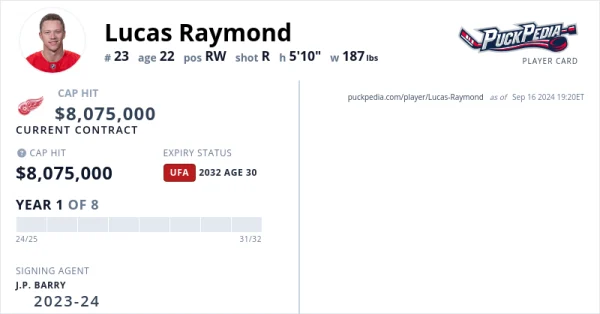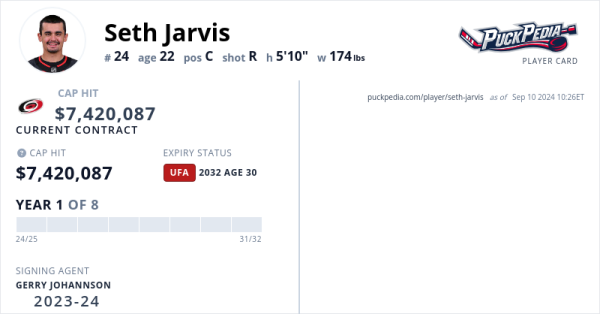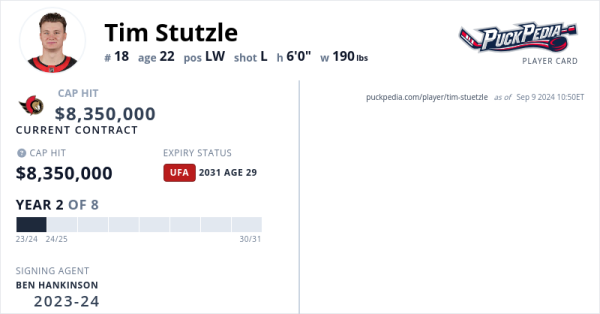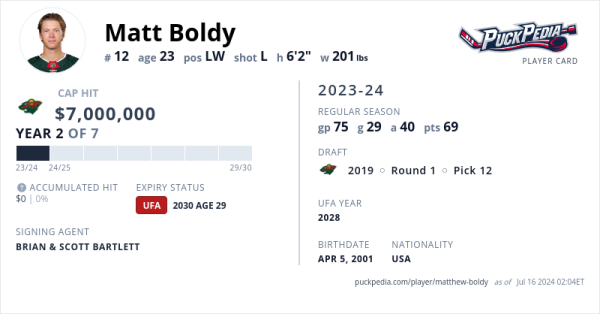
Comparing Lucas Raymond's new 8-year, $8,075,000 AAV extension to the contracts signed by other young stars in the NHL
Comparing Lucas Raymond's new 8-year, $8,075,000 AAV extension to the contracts signed by other young stars in the NHL
Lucas Raymond's new contract might just be a steal.
After a long offseason of negotiations, the Detroit Red Wings and 22-year-old winger Lucas Raymond agreed to an eight-year extension carrying a $8,075,000 AAV. For a pillar of the present and future roster, getting this deal done was one of the two most important tasks this summer. But more so than just getting a pen to paper, Detroit's patient approach also led to a favorable deal for the team. Especially in the context of some similar players, there's a lot to like about Raymond's deal.

While the team itself announced the term and cap hit of Raymond's deal, NHL insider Pierre LeBrun broke the specific details of the contract for The Athletic. Raymond's deal does not include a signing bonus, nor does the exact salary fluctuate between contract years. Raymond's final four years of the deal — that is, starting in 2028-29 — include a 10-team no-trade clause.
In order to get a sense of how valuable this deal might be for the Red Wings, let's compare Raymond's new deal to those of similar NHL stars including Seth Jarvis, Tim Stutzle and Matt Boldy.
Seth Jarvis

Given that they are both young scoring wingers with similar production, Raymond and Jarvis were frequent comparisons for each other this summer. Jarvis' deal got done first — an eight-year deal with a cap hit of $7,420,087. Now that the ink has dried on Raymond's deal, there are multiple similarities between the contracts.
For one, both stars chose the security of a long-term deal instead of trying to hit a bigger free agency jackpot by signing a bridge deal. Jarvis, too, has a modified no-trade clause that kicks in after 2028.
Where the two deals differ is the exact cap hit, as well as how that money is distributed. Jarvis' contract shaved around $400,000 off its cap hit by using deferred compensation. This means the Hurricanes will pay Jarvis one of his signing bonuses after the completion of the contract. In other words, that chunk of salary doesn't count against the cap. And if you were wondering it's totally legal — for now.
If we take Jarvis' deal into consideration without that deferred compensation, his cap hit falls closer to the $7.82 million mark, which is remarkably similar to what Raymond just signed.
In terms of what each team is paying for, the value of Raymond's contract becomes evident by comparison. Jarvis' big 67-point season in 2023-24 was a breakout year, but the previous two seasons weren't so impactful. In fact, even in Raymond's sophomore slump in 2022-23 that saw him produce just 45 points, he still outproduced Jarvis. In the case of Raymond, the resume informing the contract is a lot stronger, but the difference in salary earned isn't so vast. Depending on how the two shake out through the duration of their contracts, Raymond could prove to be the better bargain.
Tim Stutzle

Earlier this week, NHL insider Elliotte Friedman shared a story about the Raymond negotiations on his 32 Thoughts podcast. It went that Friedman believed Jarvis was an obvious comparable to Raymond given their similar profiles and production last season, but an agent stopped him to point to a different, more player-friendly comparable. He pointed to that of Tim Stutzle, the player drafted one spot ahead of Raymond in the 2022 draft, who signed an 8-year, $8.35 million AAV contract with the Ottawa Senators back in 2022.
Stutzle's contract remains the most player-favorable data point for wingers of his caliber and age given its high salary. It's so high that Friedman said teams throw it out of consideration as an Ottawa-specific deal. That's a polite way of saying the Senators' contract is a severe overpay in the eyes of their peers. Even so, Raymond could easily point to that contract as a favorable starting point for his side.
In terms of actual dollar amount, Raymond's contract is fairly similar to Stutzle's on paper. The Detroit winger is making around $300,000 less than his Ottawa peer's cap hit, and both have a 10-team no trade clause. Stutzle's deal does take advantage of signing bonuses, though the differences there affect the player's finances more than the team's cap sheer.
When comparing Raymond's contract to Stutzle's however, there are a number of considerations to take in mind to put everything in context.
First off, Canadian tax rates are higher than in the United States, meaning the actual net income of Stutzle is lower than someone signed for the same exact deal in Detroit.
In a different way, a rise in the salary cap has also devalued Stutzle's contract compared to when it was originally signed. Stutzle's deal would be worth about $8.9 million now that the salary cap is $88 million, meaning that age has cheapened the contract's cap hit.
Also worth considering, inflation in the past two years means that Stutzle's contract would be equivalent to about $8.98 million if he signed it today. The results of inflation have less impact on a system governed by a hard salary cap, though they can increase the overall value of hockey related revenue the salary cap is derived from. But considering that Stutzle's contract was negotiated with the intention of showing the world that Ottawa was investing in its stars, it is worth considering that Stutzle might have been able to demand more money if he were negotiating based on the value of today's dollar.
While a favorable data point for Raymond at the negotiating table, there are a lot of wrinkles around the Stutzle deal that make it incomparable from a more practical sense. Even so, Raymond's deal is still less than Stutzle's — both the actual contract, and some of its adjusted equivalents. Avoiding Stutzle territory is a win for Detroit.
Matt Boldy

The final entry on this list wasn't brought up so often in comparison to Raymond, but their statistical profiles are similar enough to compare. Boldy signed an eight-year, $7 million AAV contract in January 2023.
In his contract year, Boldy finished the year with 2.52 points per 60 compared to Raymond's 2.97. The majority of the difference comes from Raymond's better playmaking. Importantly, Boldy was only in the middle of his second season when he signed the deal. He had much less data to use in negotiations, while Minnesota likewise had less data to calculate the value of its investment. The Wild gambled that he would be worth his contract, allowing them to knock down the price a little bit.
In the case of Raymond, the complete opposite occurred. Detroit and Steve Yzerman sweated out Raymond all summer, signing him three days before training camp begins. On one hand, this leveraged the Red Wings' control over Raymond's RFA rights, which meant that Raymond couldn't play with anyone else unless he chose to sit out an entire season. But on the other hand, not signing Raymond to an early, mid-season extension also cost Detroit some money as he proved his value late in the season with 20 points in the final 18 games of the season.
One of the costs of Yzerman's patience during internal negotiations is that there aren't many happy surprises when it comes to contract value. Whereas his shrewdness has been questioned due to his tendency to overpay UFAs on the open market, it shows up in spades in the way he finds fair value between players and his team based on what their contracts are actually worth.
Look at it this way: Yzerman doesn't give players deals he hopes they will grow into, as is the case with many general managers today. Instead, he pays them based on what they've proven they're worth.
Raymond proved he was worth $8,075,000, and so he paid him. Compared to the Boldy contract, Yzerman can be certain Raymond earned that extra million instead of hoping he did.
Also from THN Detroit
Red Wings, Raymond Agree to Max-Term Extension
Breaking Down the Red Wings' Organizational Goalie Depth ahead of Training Camp
Berggren, Red Wings Agree to 1-year Deal
Report: Larkin AAV May Provide "Internal Cap" on Raymond, Seider Contracts
6 More Takeaways from Day 2 of Red Wings Prospect Games
6 Takeaways from Day 1 of the Red Wings’ Prospect Games
Which Red Wing RFA Will Earn More: Seider or Raymond?

